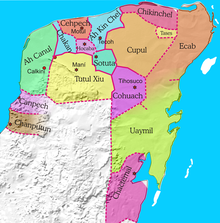Ah Canul
Ah Canul or Ah Kanul or Aj Kanul was a principality ( Mayathan : cuchcabal ) of the Maya in Yucatán during the post-classical period , which lasted until the time of the Conquest .
Description and history
The jurisdiction Ah Canul took an approximately 50 km wide and 145 km long coastal strip in the northwestern Yucatán, in the south also substantial parts of the western Puuc up to the Rio Homtun were included in the dominion area. Politically, the principality bordered Chakán in the northeast, Maní in the east and Canpech in the south.
The older history of Ah Canul can mainly be grasped archaeologically. On the territory, Oxkintoc was by far the largest center of classical music and was not finally abandoned until around 1050. Other places, especially the Puuc, have a continuous history of settlement up to the Spanish colonial era. As early as around 650 inscriptions can be found that suggest a cooperative form of government, but not the divine kingdom that was typical of an Ajaw in the classical period . The more recent history of Ah Canul is essentially derived from the Chilam Balam or from the incompletely preserved Códice de Calkiní. Another authentic source, especially on religious and mythological issues, are the Cantares de Dzitbalché .
With the fall of Mayapán in the middle of the 15th century, nine officers (gate) guards ( canul ) from Mayapán are said to have gone to the north and founded the principality. They were not only founders of the principality in the political and eponymous sense, but also of the most influential family. Ah Canul had no central authority in the 16th century either, so it was not ruled by a Halach Huinik like the principalities of Cochuah , Sotuta or Ah Kin Chel . The majority of the Canul family made up the Batab in larger towns . This was the highest secular office in times of peace and corresponded to a city prince or local governor. In this respect, Ah Canul can best be compared with Cupul . A major difference, however, was that Ah Canul was not at war with his neighbors and was largely neutral to benevolent towards the Spaniards even during the uprisings against colonization and Christianization. Unaffected by this, members of indigenous aristocratic families , as in most other Mayan cities in the Yucatán, were often able to continue to occupy leading positions even after the conquest and Christianization. For example, numerous representatives of the old elite are named among the caciques and local governors of the 16th century.
In the 17th century disease and exploitation led to rapid changes in the social fabric. The present-day towns of Calkiní, Dzitbalché, Halachó, Hecelchakán, Hunucmá, Maxcanú, Sisal, Tenabo and Ucú have a history of settlement up to pre-colonial times, in some cases up to the classical period.
literature
- Ralph L. Roys : The Political Geography of the Yucatan Maya. Washington 1957, pp. 11–33 (online preview)
Individual evidence
- ↑ a b Nikolai Grube (ed.): Maya. God kings in the rainforest . Könemann-Verlag, Cologne 2000, pp. 336–337
- ↑ Códice de Calkiní brief description (Spanish)
- ↑ Tsubasa Okoshi Harada: Códice de Calkiní , México 2009 ( PDF )
- ↑ Cantares de Dzitbalché ( Memento of September 27, 2007 in the Internet Archive ) Brief description (Spanish)




